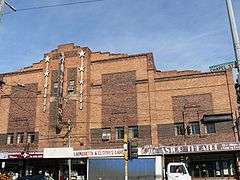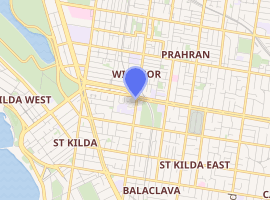The Astor Theatre, Melbourne
The Astor Theatre is a classic, single-screen revival movie theatre located in the inner Melbourne suburb of St Kilda, that has a long and illustrious history.[1] The site at 1-3 Chapel Street was first used for public entertainment in 1913 when Thomas Alford established the Diamond Theatre, which shared the site with a confectioner and livery stables. Part vaudeville theatre and part cinema, in 1914 it was renamed the Rex before closing in 1917. By 1924 the site had been occupied by a motor garage.
| The Astor Theatre | |
|---|---|
 The Astor Theatre front facade from Chapel Street. | |

| |
| General information | |
| Architectural style | Art Deco[1] |
| Town or city | Chapel Street, St Kilda (Melbourne), Victoria |
| Country | Australia |
| Coordinates | 37.85806°S 144.99194°E |
| Construction started | December 1935[2] |
| Completed | 3 April 1936[2] |
| Design and construction | |
| Architect | Ron Morton Taylor[2] |
History
In 1935 Alford sold the property to Frank O'Collins. After council approval was received in October, demolition of the site's original buildings commenced in December. Construction began shortly afterwards, O'Collins having commissioned architect Ron Morton Taylor (among the earlier work of which included the State (now Forum) Theatre on Flinders Street) and construction firm Clements Langford. Work progressed rapidly and the new Astor Theatre was officially opened on 3 April 1936.
The design of the theatre is in the Art Deco style typical of the time.[1] Notably it was one of the last theatres in Melbourne to use the traditional two-level auditorium layout; the stall-and-circle arrangement falling out of favour for its cost during the post-war years. Originally it had a seating capacity of 1,673 people.
The theatre has changed ownership several times, undergone redesign and survived redevelopment proposals to remain a Melbourne landmark venue. [2] The Astor Theatre is listed on the Victorian Heritage Register, under record number H1751.[3] It is also one of the rare contemporary theatres that consistently maintains the tradition of showing Double feature screenings for the price of single films.
In 1983, The Astor Theatre was leased by George Florence, who still runs the business. Florence developed the programming style of The Astor, and the format of its quarterly calendar of forthcoming films. In August 2012, St Kilda businessman Ralph Taranto bought the Astor for an undisclosed sum believed to be less than the $3.8 million St Michael's paid for it at auction in 2007. He intended to leave the running of the cinema in the hands of Florence. When asked if his intention was to keep it as a single-screen cinema, Taranto's response was simple: Oh God yes. I wouldn't buy it otherwise.[4]
Whilst on 23 August 2014 it was announced that the Astor would close in early 2015[5] this changed when Palace Cinemas agreed to become the new tenant with apparent intent to 'continue business largely as it is', according to The Age. Palace announced that the cinema will reopen as is in June 2015 after some minor renovations to the candy bar.[6]
References
- The Astor Theatre. Accessed 3 July 2007.
- RMIT - The History of "The Astor Theatre" Archived 19 August 2006 at Archive.today. Accessed 3 July 2007.
- Building details on the Heritage Victoria website
- "Astor saga nears happy ending". The Age. 24 August 2012.
- "The Astor Theatre to close in 2015". Sydney Morning Herald. 23 August 2014.
- "Is this the happy ending The Astor has been waiting for?". The Age. 13 December 2014.